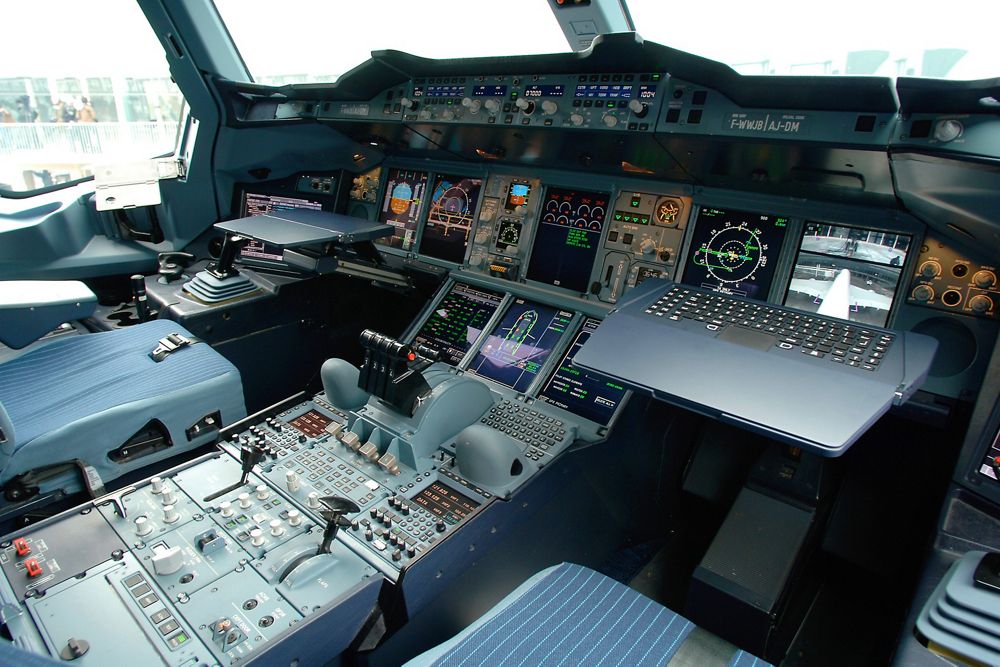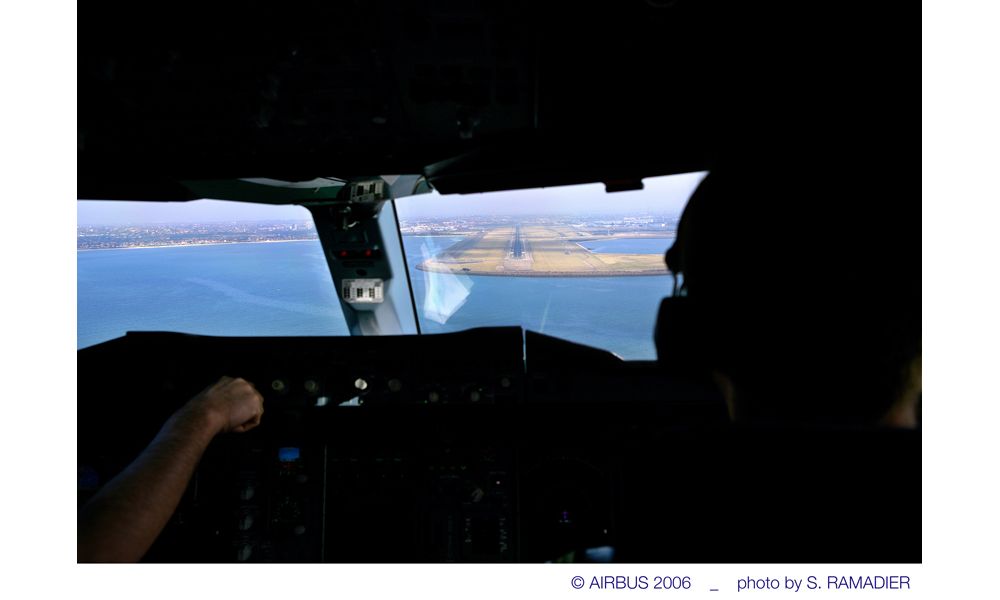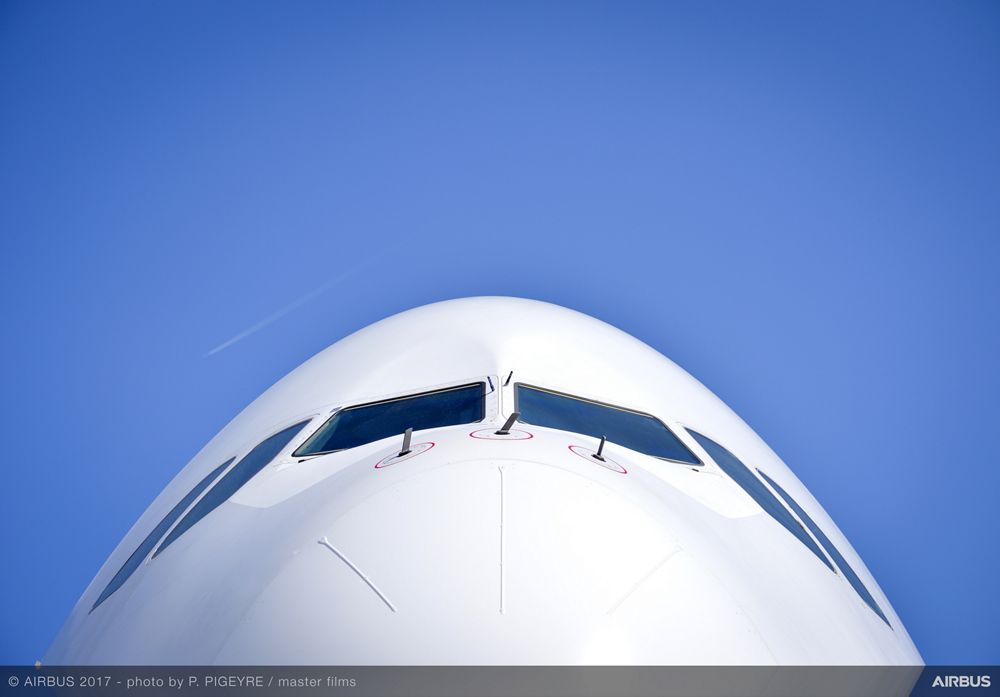
Revenue generation
The A380’s service
introduction ushered in a new era of airline transportation for
operators. Whether it’s being used to reduce the number of flights and
create cost savings while maintaining capacity, or to offer more
capacity with fewer takeoff slots, the A380 brings operators a wide
range of commercial advantages. Furthermore, with two full-length
decks, more space for every passenger, and a flying experience no other
aircraft in the sky can match, the A380 has become a must-have ticket on
every route it flies – resulting in a significant first-mover advantage
for operators.
The A380’s cockpit – which is based on Airbus’
industry-leading flight deck design for its fly-by-wire jetliner
families – features the latest advances in cockpit technology, including
larger interactive displays, an advanced flight management system and
improved navigation modes.
The A380's main instrument panel incorporates eight identical and interchangeable Liquid Crystal Display Units, providing a primary flight display, navigation display, two multi-function displays, an engine warning display and a systems display. The increased display size provides increased perspective for pilots and allows for enhanced presentation modes as a vertical situation awareness function that presents a “vertical cut” of the aircraft trajectory incorporating flight path, terrain and weather information.
A key A380 innovation is the use of an electronic library to largely replace the traditional paper documentation used by pilots. This library allows flight and maintenance crews to easily locate relevant operational information in the various flight manuals, lists and logbooks, while enabling an optimisation of performance and weight-and-balance computations.
The A380's main instrument panel incorporates eight identical and interchangeable Liquid Crystal Display Units, providing a primary flight display, navigation display, two multi-function displays, an engine warning display and a systems display. The increased display size provides increased perspective for pilots and allows for enhanced presentation modes as a vertical situation awareness function that presents a “vertical cut” of the aircraft trajectory incorporating flight path, terrain and weather information.
A key A380 innovation is the use of an electronic library to largely replace the traditional paper documentation used by pilots. This library allows flight and maintenance crews to easily locate relevant operational information in the various flight manuals, lists and logbooks, while enabling an optimisation of performance and weight-and-balance computations.

Airbus
introduced its innovative Brake to Vacate technology on the A380,
allowing flight crews to more effectively manage approach and landing by
pre-selecting the optimum runway exit. This can reduce runway occupancy
time by up to 30 per cent – significantly increasing the number of
aircraft that can be handled by the world’s airports.
By incorporating the latest advances in structures and
materials, the A380 offers the lowest cost per seat of any widebody
aircraft, over 15 per cent lower than its nearest competitor. This
includes the use of advanced aluminium alloys for the wing and
fuselage,
along with the extensive application of composite materials in the centre wing box’s primary structure, wing ribs, and rear fuselage section.
The A380 also uses Glare™ material in the pressurised fuselage’s upper and lateral shells. Glare™ is a laminate incorporating alternate layers of aluminium alloy and glass fibre reinforced adhesive, with its properties optimised by adjusting the number of plies and orientation of the glass tapes. This offers a significant reduction in weight and provides advanced fatigue and damage resistance characteristics.
along with the extensive application of composite materials in the centre wing box’s primary structure, wing ribs, and rear fuselage section.
The A380 also uses Glare™ material in the pressurised fuselage’s upper and lateral shells. Glare™ is a laminate incorporating alternate layers of aluminium alloy and glass fibre reinforced adhesive, with its properties optimised by adjusting the number of plies and orientation of the glass tapes. This offers a significant reduction in weight and provides advanced fatigue and damage resistance characteristics.
At
the 2017 Paris Air Show, an A380 flight test aircraft was displayed
with the new large winglets conceived by Airbus as part of aerodynamic
refinements for the A380plus version
Two new-generation engine options (the Engine Alliance GP7200
and Rolls-Royce Trent 900), combined with an advanced wing and landing
gear design, make the A380 significantly quieter than today's largest
airliner – enabling this very large aircraft to meet strict local
regulations at airports around the world.
With a new wing design and composite materials accounting for 25 per cent of its structural weight, the A380 is the most efficient aircraft all around. By producing only about 75 grams of CO2 per passenger kilometre, the A380 is helping the aviation industry's commitment to minimise greenhouse gas emissions.
A380 reliability and maintainability is further increased with modern technology, including an enhanced onboard central maintenance system and variable frequency generators – which simplify the large aircraft’s electrical generation network. Hydraulic power is provided by two fully independent systems with an operating pressure of 5,000 psi., instead of the conventional 3,000 psi. This capacity for higher pressure results in smaller and lighter hydraulic system equipment, as well as less hydraulic fluid on board, proving how Airbus innovations continue to deliver efficiency in every area of aircraft design and manufacture.
With a new wing design and composite materials accounting for 25 per cent of its structural weight, the A380 is the most efficient aircraft all around. By producing only about 75 grams of CO2 per passenger kilometre, the A380 is helping the aviation industry's commitment to minimise greenhouse gas emissions.
A380 reliability and maintainability is further increased with modern technology, including an enhanced onboard central maintenance system and variable frequency generators – which simplify the large aircraft’s electrical generation network. Hydraulic power is provided by two fully independent systems with an operating pressure of 5,000 psi., instead of the conventional 3,000 psi. This capacity for higher pressure results in smaller and lighter hydraulic system equipment, as well as less hydraulic fluid on board, proving how Airbus innovations continue to deliver efficiency in every area of aircraft design and manufacture.
The interactive map above highlights the optimised range of this
modern Airbus jetliner. To determine the aircraft’s range from a
specific location, simply drag the cursor to any city or region. The
area covered in blue will represent all possible destinations within its
typical range.
Note: The range areas above illustrate the aircraft's nominal range.
Note: The range areas above illustrate the aircraft's nominal range.











No comments:
Post a Comment